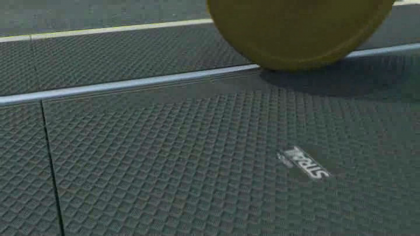Twelve years after Portland Streetcar added its rails to city streets, it’s still a Portland rite of passage to crash your bike on its tracks — and it’s still a maddening problem for the handful of people trying to solve it.
“I just can’t believe that in a place like Amsterdam or any number of European cities where they have had girder rail — I can’t believe that somebody hasn’t figured this out,” Portland Streetcar consultant Carter MacNichol said in an interview Wednesday. “But apparently they haven’t.”
MacNichol, who occasionally researches the issue on his own time, said he’s currently hoping for an email reply from veloSTRAIL, a German company that makes plastic inserts for urban rail crossings designed to collapse beneath a streetcar wheel but not beneath a bike. But veloSTRAIL, he said, seems to be designed for T-shaped ballasted tracks — not the C-shaped girder rail used by Streetcar.
The essential problem for all such inserts, MacNichol said, is that they have to reliably bounce back into place after the streetcar passes by.
“If it doesn’t come back, it probably will be more dangerous, because people will think it’ll come back but it won’t be,” he said.
Meanwhile, the website Streetfilms yesterday shared news of a similar product being used in Zurich. Videographer Clarence Eckerson also made this video showing how skillfully many of that city’s bikers navigate the tracks:
Some of us, of course, are more skilled than others. I never thought I’d fall on the Streetcar tracks until the day I did, botching a right turn while southbound on Martin Luther King Boulevard. This summer, a doctor whose practice is in the Pearl District joked ruefully to me that he sees so many streetcar injuries that he should be offering the city a commission.
Steve Bozzone of multimodal transportation advocacy group Active Right of Way wrote last week that his organization’s streetcar crash reporting tool attracts 90 voluntary reports each year.
Art Pearce, a streetcar project manager for the City of Portland, said he doesn’t know of any active effort in the city to look for solutions to this ongoing problem.
Ted Buehler, also of Active Right of Way, said his own research has shown that the eastside streetcar tracks are more dangerous than the westside — both because the eastside tracks are on bigger streets with faster traffic, and because they were often set into the street with a bigger bump between the track and the pavement.
“They did a poor job of installation, and so the rail might be three-eighths or a half-inch above the pavement versus one-eighth to a quarter inch,” Buehler said of the eastside track, based on 20 measurements he’d taken during construction. “The higher the bump, the more likely it is to knock you off balance.”
MacNichol, the Portland Streetcar consultant, said he hasn’t given up hope for a plastic solution.
“It might be a great patent that you could get if you could figure it out. I wish I could,” he said. “Believe me, I think it would be a great thing if we could figure it out.”

